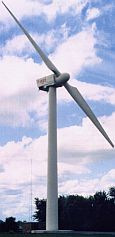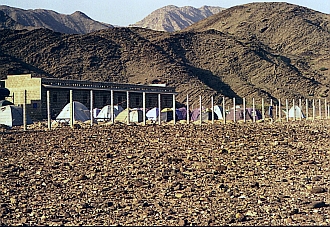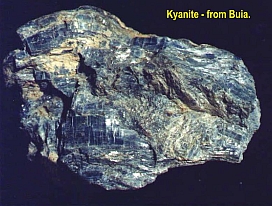Wind Power: an Ideal Site in Eritrea
.
 .
.A 1 MW Wind Turbine
Climbing in solitude the small chain of kyanite-rich hills, which fall on the plain of Wangabo where it ends just under the Eritrean highlands shouldering to the west the Village of Buya, among hyenas in the dead of the night might not be a very exhilarating experience hence I don’t know what really happens on these hills under the moon.
Things are different in the daytime. The climb is easy even if under the scorching sun of north Dankalia and it is less than half an hour walk from Buya’s village. On the way you meet a few curious squirrels and occasionally a gazelle and if you are lucky you may find something as astounding as the rings of the exoskeleton of an annelid orderly fitted with small pellets of squirrel’s dung inside, probably the work of some large scarabs.
Once on top, whatever the hour of the day, you start fighting with strong winds which do their best to unbalance you and steal the hat from your head to have it baked under the sun.
These winds or better – turbulence – is caused by the heating
sands of the desert below Buya’s village, a desert which extends towards
Bada to the east running below the Alid volcano and just a few miles
away from the Homo Buya site of Alat and from there all the way down
in the plain of Samoti.
.
What you realize once up there is that this turbulence, which if funneled right across these hills and which is active all the days throughout the year might easily and unremittingly set in motion a small chain of large wind turbines in the 1000 kW (1MW) range.
Thinking about the power requirements of a small country like Eritrea a small chain of these wind turbines would supply several megawatts of electricity - Typically, a 1-megawatt wind turbine costs about $1 million to develop. The other large expense, apart from basements and setting the turbines in place, would be linking the output to the national electric grid, a cable line over 70 km long all the way from Buya to Massawa’s new Electric Power Plant.
That done the country would be greatly relieved from the weight of fuel costs necessary to keep towns, villages and the national industry supplied with constantly growing electrical requirements.
This is just an idea but, given the possibility of realizing
it due to apparently favorable environmental conditions it might be
seriously taken into consideration.
..
|
Above: the small hills behind the village of Buya, Northern Dankalia. In the foreground an encampment of the researchers of Florence's University (Italy) who discovered Buya's Homo in Alat. |
Kyanite is an aluminum silicate industrially used in refractory and ceramics industry. It crops out in veins on the hills west and south of Buya and is easily found as large, loose specimens downhill. |
|


